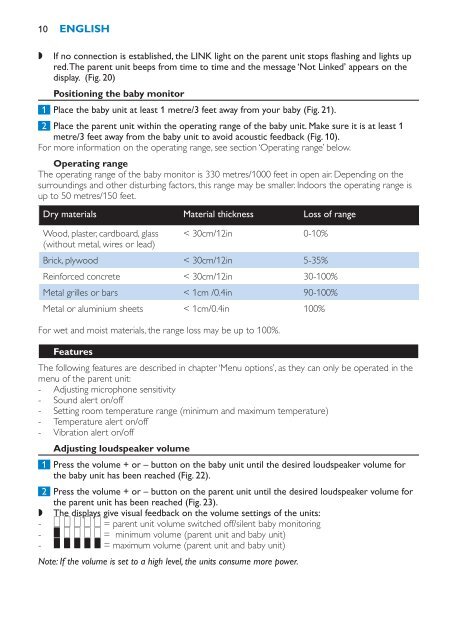Philips Avent DECT baby monitor - User manual - HUN
Philips Avent DECT baby monitor - User manual - HUN
Philips Avent DECT baby monitor - User manual - HUN
You also want an ePaper? Increase the reach of your titles
YUMPU automatically turns print PDFs into web optimized ePapers that Google loves.
10<br />
English<br />
,,<br />
If no connection is established, the LINK light on the parent unit stops flashing and lights up<br />
red. The parent unit beeps from time to time and the message ‘Not Linked’ appears on the<br />
display. (Fig. 20)<br />
Positioning the <strong>baby</strong> <strong>monitor</strong><br />
1 Place the <strong>baby</strong> unit at least 1 metre/3 feet away from your <strong>baby</strong> (Fig. 21).<br />
2 Place the parent unit within the operating range of the <strong>baby</strong> unit. Make sure it is at least 1<br />
metre/3 feet away from the <strong>baby</strong> unit to avoid acoustic feedback (Fig. 10).<br />
For more information on the operating range, see section ‘Operating range’ below.<br />
Operating range<br />
The operating range of the <strong>baby</strong> <strong>monitor</strong> is 330 metres/1000 feet in open air. Depending on the<br />
surroundings and other disturbing factors, this range may be smaller. Indoors the operating range is<br />
up to 50 metres/150 feet.<br />
Dry materials Material thickness Loss of range<br />
Wood, plaster, cardboard, glass < 30cm/12in 0-10%<br />
(without metal, wires or lead)<br />
Brick, plywood < 30cm/12in 5-35%<br />
Reinforced concrete < 30cm/12in 30-100%<br />
Metal grilles or bars < 1cm /0.4in 90-100%<br />
Metal or aluminium sheets < 1cm/0.4in 100%<br />
For wet and moist materials, the range loss may be up to 100%.<br />
Features<br />
The following features are described in chapter ‘Menu options’, as they can only be operated in the<br />
menu of the parent unit:<br />
--<br />
Adjusting microphone sensitivity<br />
--<br />
Sound alert on/off<br />
--<br />
Setting room temperature range (minimum and maximum temperature)<br />
--<br />
Temperature alert on/off<br />
--<br />
Vibration alert on/off<br />
Adjusting loudspeaker volume<br />
1 Press the volume + or – button on the <strong>baby</strong> unit until the desired loudspeaker volume for<br />
the <strong>baby</strong> unit has been reached (Fig. 22).<br />
2 Press the volume + or – button on the parent unit until the desired loudspeaker volume for<br />
the parent unit has been reached (Fig. 23).<br />
,,<br />
The displays give visual feedback on the volume settings of the units:<br />
--<br />
g = parent unit volume switched off/silent <strong>baby</strong> <strong>monitor</strong>ing<br />
--<br />
h = minimum volume (parent unit and <strong>baby</strong> unit)<br />
--i = maximum volume (parent unit and <strong>baby</strong> unit)<br />
Note: If the volume is set to a high level, the units consume more power.
















